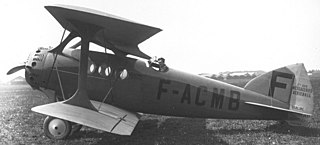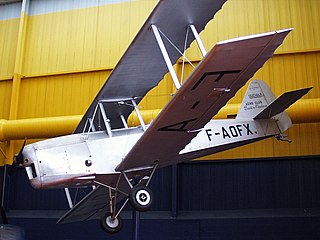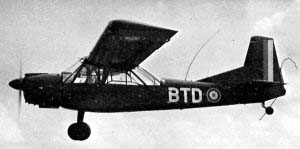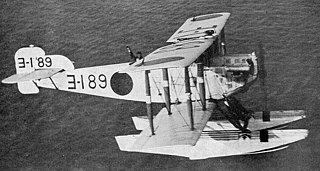Related Research Articles

The Caudron C.59 was a French, two-seat biplane with a single engine and a canvas-covered fuselage, produced between 1922 and 1924. Suitable for a variety of roles, more than 1,800 Caudron C.59s were manufactured.

The Bleriot-SPAD S.33 was a small French airliner developed soon after World War I. The aircraft was a biplane of conventional configuration whose design owed much to the Blériot company's contemporary fighter designs such as the S.20. Four passengers could be accommodated in an enclosed cabin within the monocoque fuselage, and a fifth passenger could ride in the open cockpit beside the pilot. A great success, the S.33 dominated its field throughout the 1920s, initially on CMA's Paris-London route, and later on continental routes serviced by Franco-Roumaine.

The Blériot-SPAD S.61 was a French fighter aircraft developed in 1923. Designed by André Herbemont, the S.61 was a conventional biplane, abandoning the swept upper wing used by Herbemont in several previous designs. The prototype S.61 was evaluated by the French Air Force alongside the S.51 as a potential new fighter, but like its stablemate, was rejected. The Polish Air Force was impressed enough to order 250, as well as purchase licences for local production. The Romanian Air Force also ordered 100 aircraft. About 30 were built in Poland, by the CWL.

The Caudron C.270 Luciole ("Firefly") was a sporting, touring and trainer aircraft produced in France in the 1930s, derived from the C.230.

The Fokker F.XIV was a cargo plane built in the Netherlands in the late 1920s by Fokker. It was a high-wing cantilever monoplane of conventional trimotor layout. The sole example was tested by KLM but never put into service.

The ICAR 36 / ICAR Comercial (sic), variously also known as the ICAR M 36, Messerschmitt M 36 or BFW M.36, was a Messerschmitt design built and tested by the Romanian company ICAR in the mid-1930s. It was a small, single-engine high-wing airliner, the first civil transport aircraft built in Romania.

The Lorraine-Hanriot LH.10 was a family of training monoplanes built in France in the early 1930s, the most widely produced and well-known member of which was the LH.16, later known simply as the Hanriot H.16. It was a conventional parasol-wing monoplane with fixed tailskid undercarriage, the main units of which were mounted on outriggers attached to the wing struts. The pilot and instructor sat in tandem open cockpits.

The Hanriot H.43 was a military utility aircraft produced in France in the late 1920s and early 1930s which was primarily used by the Aéronautique Militaire as a trainer. While Hanriot had spent most of the 1920s manufacturing further and further developments of the HD.14 that had flown in 1920, the H.43 was an entirely new design. It was a conventional single-bay biplane with staggered wings of unequal span and a fuselage of fabric-covered metal tube. Accommodation for the pilot and passenger was in tandem, open cockpits and the main units of the fixed, tailskid undercarriage were linked by a cross-axle.

The Nord 3400 Norbarbe was a French two-seat observation and casualty-evacuation aircraft built by Nord Aviation for the French Army Light Aviation.
The Nieuport-Delage NiD 640 was a French four-passenger transport monoplane built by Nieuport-Delage.

The Potez 32 and its military version the Potez 33 was a single-engine French monoplane transport built by Potez and based on the Potez 29 biplane.

The Yokosuka E1Y was a Japanese floatplane of the 1920s. A single-engined biplane that was designed and developed by the Yokosuka Naval Air Technical Arsenal as a reconnaissance aircraft for the Imperial Japanese Navy, 320 were built as the Type 14 Reconnaissance Seaplane, entering service in 1925 and remained in operational service until 1932.
The Aichi F1A was a prototype Japanese floatplane of the 1930s. A single-engined biplane, the F1A was intended as a short-range observation aircraft suitable for operation off the Imperial Japanese navy's warships, but only two were built, the Mitsubishi F1M being selected instead.

The SAB-SEMA 10 was a single-engine advanced trainer, designed and built in France as the SEMA 10, in the 1930s. It failed to win a French production contract and only one was built. Re-engined, modified and redesignated SAB-SEMA 12, it served with the Spanish Republican Air Force at the beginning of the Spanish Civil War.
The Morane-Saulnier MS-700 Pétrel was a French four-seat cabin-monoplane designed and built by Morane-Saulnier, only three prototypes were built.
The Lorraine 7M Mizar, also called the Lorraine 240CV Mizar, was a seven-cylinder air-cooled radial engine designed and built in France during the 1920s and 1930s. Nominal power was given as 240 hp (180 kW) at 1500rpm, with a maximum output of 283 hp (211 kW) at 1800 rpm.
The Caudron C.251 Et-2 was a French tandem seat, open cockpit biplane designed as an intermediate trainer and built in 1931. It did not go into production.

The Lorraine Hanriot LH.41 was a single-seat racing aircraft designed and built in France specifically to compete in the Coupe Michelin air races, held in France.
The Lorraine-Hanriot LH.30 was a training monoplanes built in France in the early 1930s.
The Lorraine-Hanriot LH.60 was a training monoplane built in France in the early 1930s.
References
- ↑ "C.A.M.S. 90 - Hydravion d'observation - Un siècle d'aviation française". Aviafrance.com. 2000-05-13. Retrieved 2019-02-04.